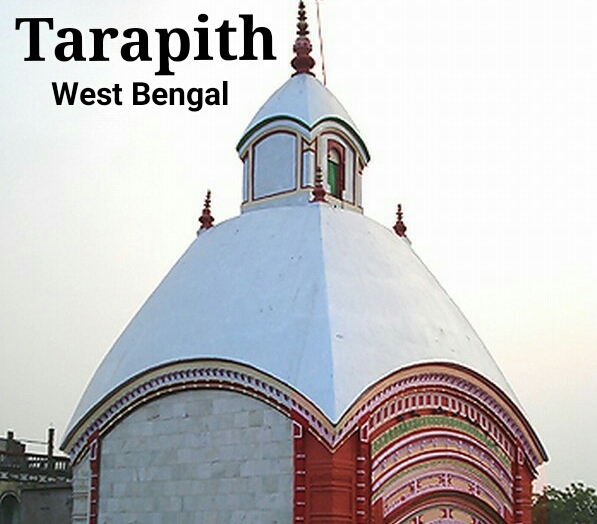The very word Tara brings fear into many minds. For me, she is a breeze in the hot summer bringing in joy of the voids, takes to the mesmerizing worlds where whatever we see and experience become real. Ma Tara is regarded as second in the Dasa-Mahavidyas and the School of Tara has its origins to the land of upper Himalayas, into Tibetan Buddhism and the lands of “Maha Cheena” or Great China. Temples of Tara as a goddess are very rare find, in fact, there is only one established temple in India known as Tarapith.
Worship of Tara is taught to be forbidden to houses and not many are found to know even such a goddess exist. Ironically the verbal meaning of Tara is the one who protects. She is often depicted as holding a sword, a scissor, blue lotus and a cup of elixir, eyes red due to intoxication, wearing a crown made of five skulls and a snake on the hair known as Akshobhya, standing with her left feet on the chest of Shiva, with fierce looks, disheveled hair like fire, drenched in human blood, wearing a Munda mala (Garland of Skulls) and pregnant. Tradition is that Parvathi, took this form to suckle the Shiva to save him from doomed after drinking the great poison after churning the milky ocean. She was pregnant and from her the universal cosmos – Narayana was born. In Tibetan Buddhism, she is regarded as the lady Buddha, the mother of liberation.

One of the prime center of worship of Tara, Tharapith temple regarded as one of the 51 Sakthi Pithas in the country is situated near Rampurhat in Birbhum District of West Bengal. I reached on a late afternoon at Kolkata from Chennai. The next day I had to participate in a family held rath yatra of my friend, another friend of mine insisted that I should leave ahead to Tarapith. As it is very normal for any Bengali person to be pride of their family tradition and upholding even tiniest of the celebrations, the day went well with pujas, bhogh and ended with a heavy sumptuous Bengali meal rich in delicacies.
Even though there are buses and trains till Durgapur or Burdwan to reach Tarapith, I had decided to take a cab for a safer journey. Started around 6 AM in the morning from Kolkata, proceeded towards Tarapith across the beautiful lands of West Bengal. The roads were not good, however, we have managed to reach by lunch time. Tarapith has become a small town now due to heavy rush of pilgrims, till recent past it was a less populated village with remote facilities. The temple is built around the lands known as Maha Smashan, the big cremation grounds. The cremation grounds have now shrunk to a very small area where the banyan tree hoisting her appearance place under which 1 lakh skulls are said to be buried.
The Maha Smashan is filled with huts where tantrics still live and practice and are elusive as much as it were in past. The main temple is built in medieval terracotta temple style in Bengali architecture. The shrine holds a stone idol of Tara in the form of suckling Shiva. No one can see the main deity, a camouflaged silver icon covers it for public worship. She is seen with her tongue protruding out, mouth smeared with blood and eyes which deeply penetrating. In front of the shrine is an ardha mandap where we can calmly watch the idol. Her consort Shiva has a separate shrine, beneath the shrine is a pond. In front of ardha mandap is the bali pitha, where goats are sacrificed almost every day in many numbers. As I sat there, in less than an hour many goats were sacrificed. The energy is serene and calm.
We left to the Maha Smashan nearby where the banyan tree, the footprints of Tara are also seen, next to the tree were several samadhis, one of which is that of the famous Baamakhaipa, who was an ardent devotee of Tara, spent his full life in that cremation grounds. We could see many “bhairavies” and “yoginis” wandering there with a smile which can enchant you in seconds.
Walking deep to the cremation grounds, one can still see alive funeral pyres, age-old trees and the river Dwarka flowing serenely near to the land. I could see many maha sankhas (skull) scattered around, many of them used in tantric rituals. I started meditation for a while, near to the place where “Tara Bali” was given, very deep and refreshing it was suddenly the voice of our Baba fell to my ears, “I told you not to sit alone, it’s getting too late”. He was right, it is not a place for loners, neither it is meant for a casual visit in the nights as there are still tantricks who does anything to please their goddess.
The town became sleepy by seven. Next morning I went to nearby ghat called as Mundamalini ghat, because it is believed that Ma Tara had removed her Mundamala here before taking the bath. Rain started heavily as I approached the Mundamalini ghat. Water was clean, I took a dip bath to refresh myself. The ghat is surrounded with many samadhis, and besides heavy rush of pilgrims, the ghat looked clean and maintained.
Tarapith is a temple that stands still on the contradiction to modern day religion; alcohol, fish and meat are offered to goddess, deities are bathed in alcohol. Unlike South Indian shrines, we can hug the deity and worship ourselves. Beware of pujaris who easily trick devotees for money.
One word of caution to people who visit, make sure you wear less jewellery, do not wander after sunsets especially Maha Smashan can be avoided after sunset for personal safety.
- The mysterious Kamakhya Devi of Nilanchal - September 26, 2016
- Visiting the unknown goddess of Tarapith - September 7, 2016




